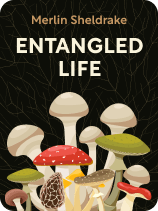

This article is an excerpt from the Shortform book guide to "Entangled Life" by Merlin Sheldrake. Shortform has the world's best summaries and analyses of books you should be reading.
Like this article? Sign up for a free trial here.
What’s the book Entangled Life about? How do fungi improve humanity?
In Entangled Life, Merlin Sheldrake argues that fungi are an understudied group of organisms that challenge our imaginations. Additionally, they offer promising solutions to modern-day problems such as mental illness and environmental destruction.
Read below for a brief overview of the Entangled Life book to get the main ideas.
Entangled Life by Merlin Sheldrake
Not long after publishing the Entangled Life book, biologist Merlin Sheldrake made a meal out of two copies of the book. He dampened the pages of the first copy, inoculated it with fungal spores, and feasted on the mushrooms that burst from its pages. He then macerated the pages of the second copy and fermented them into a beer he drank.
Sheldrake’s process of transforming these copies of his book embodies the themes he explores throughout its chapters. He examines what we know and don’t yet know about fungi, these mysterious organisms that transform their surroundings—and us.
Sheldrake is a British biologist who specializes in fungal biology. Entangled Life, published in 2020, is his first book. It’s not only a book for fans of eating and foraging for mushrooms: It’s for anyone interested in biology, environmentalism, biotechnology, and philosophy.
Throughout this article, we’ll present Sheldrake’s insights on what we know—and still don’t know—about fungi. In Part 1, we’ll examine the basics of fungal biology, from the structure of their cells to their partnerships with other organisms. In Part 2, we’ll explore why fungi matter by describing how they challenge our imaginations and offer solutions to pressing, modern-day problems such as mental illness and environmental destruction.
Part 1: Fungal Biology
Fungi are their own kingdom of organisms—they’re neither plants nor animals. Although the field of mycology (the study of fungi) is growing, Sheldrake argues that many aspects of fungal biology remain a mystery. Experts estimate that we’ve only formally described 6% of all fungi species.
According to Sheldrake, fungi are understudied for two main reasons. First, fungi are hard to access because many of them live underground. Second, the study of fungi requires various types of biologists to collaborate since fungi’s lives are deeply intertwined with those of other organisms—but it’s rare for biologists to collaborate with researchers outside their own subfield (such as microbiology).
In this section, we’ll explore Sheldrake’s insights on what we know and don’t yet know about fungal biology. We’ve organized this information into six subsections, one for each property of life. Biologists generally agree that all living things possess these six properties of life: organization, growth, response to stimuli, reproduction, energy processing, and homeostasis.
Property 1: Organization
All living things have internal organization—structures such as cells, roots, and organs that organize their matter. Sheldrake explains that the cell is the main structure in unicellular fungi, such as yeast. However, most fungi are multicellular organisms whose cells form larger structures.
(Shortform note: Some fungi are dimorphic: They switch between being unicellular yeasts and multicellular organisms. They make this switch in response to environmental changes, suggesting that this ability to transform is an adaptation that enables their survival.)In this section, we’ll explore three structures found in multicellular fungi. First, we’ll describe hyphae—long chains of cells surrounded by a cell wall. Then, we’ll examine two larger structures made of hyphae: mycelia (which typically grow underground) and mushrooms (which typically grow above ground).
Property 2: Growth
All organisms grow cells and larger structures according to genetic instructions. We’ll begin this section by examining the overall process of fungal growth. Next, we’ll explore two types of growth: branching and fusing.
The Process of Fungal Growth
According to Sheldrake, multicellular fungi grow by lengthening their hyphal tips—the ends of their mycelia. By contrast, most other multicellular organisms grow by building layers of cells, like a 3-D printer.
Furthermore, Sheldrake elaborates that fungal growth is both fast and forceful. Let’s further explore these two ideas.
Fungal growth is fast: Small packets containing the materials for cell growth travel through a fungus’s mycelium, arrive at a hyphal tip, and add new cells to the chain—at a rate of over five hundred packets per second.
Fungal growth is forceful: Fungi eat by digesting organic matter in their surroundings, so they need a method for inserting themselves into this matter. They use specialized hyphae that build up a high internal pressure so they can bust through cell walls.
Two Types of Fungal Growth: Branching and Merging
According to Sheldrake, when hyphae lengthen, they either branch into new territory or fuse with the fungus’s existing mycelium. Let’s further explore both types of fungal growth.
Branching: Sheldrake explains that mycelia branch radially from a spore (a fungi’s first cell). This radial branching allows a mycelium to expand into vast territories.
Fusing: Whereas branching is all about expanding a fungi’s territory outward, fusing is about creating a density of connections within a mycelium. When one hyphal strand fuses with another, it creates a shortcut, allowing materials (such as water and nutrients) and chemical signals (which we’ll explore later) to travel rapidly from one part of a fungus to another part.
Property 3: Response to Stimuli
All living things react to environmental stimuli, such as light and the presence of other organisms. According to Sheldrake, multicellular fungi’s responses to stimuli are closely connected to their growth, as outlined in these two steps:
Step 1: Expansion and investigation. As a mycelium radiates from its spore, its many hyphal tips sense stimuli it encounters. A single mycelium might contain between a hundred and a billion hyphal tips that can detect a range of stimuli, such as light and gravity.
Step 2: Directional growth. When a fungus’s hyphae sense a desirable stimulus (such as a nutrient source), its mycelium continues branching and merging its hyphae to surround that source. Meanwhile, it retreats from areas with no stimuli or undesirable stimuli (such as toxins).
Property 4: Reproduction
All life forms reproduce by replicating their DNA and passing it to the next generation. We’ll outline the multicellular fungi’s typical process for reproduction.
Step 1: Attraction. According to Sheldrake, fungi release sex pheromones (a chemical signal) to attract mates. (Shortform note: According to other researchers, fungal sex pheromones don’t only attract mates. These sex pheromones can also induce the creation of fungal sex organs—specialized hyphae that produce gametes (the equivalent of sperm and eggs).)
Step 2: Sex. After attraction, two fungi start having sex when a hypha from one mycelium fuses with the hypha of another. Their genetic material meets and combines in this fused channel.
Step 3: Spore dispersal. After sex, one of the fungi grows flesh that develops into spores—cells containing the new genetic material. Then, this fungus disperses those spores. Although not all fungi use mushrooms for this step, Sheldrake focuses on describing several of the ways mushrooms spread spores:
- Explosive ejection: Some mushrooms eject spores into the air at high speeds. (Shortform note: Many of these mushrooms are able to achieve high speeds because they use fluid-filled tubes that shoot out spores, like a water gun.)
- Animal consumption: When animals eat mushrooms, they deposit the spores within their feces in a new location. (Shortform note: Conservation biologists sometimes measure spore levels in animal feces to predict the distribution of hard-to-find fungi.)
- Invasion: Some fungi invade organisms’ bodies. For example, Ophiocordyceps—the “zombie ant fungus”—infects an ant, manipulates its behavior so it crawls to an elevated location, then bursts from the ant’s head, showering its spores onto the forest floor.
Property 5: Energy Processing
All organisms acquire energy to fuel their growth, reproduction, and other processes. Sheldrake explains that fungi, like humans and other animals, are heterotrophs: Instead of producing their own food (as plants do), they acquire energy by eating other organisms. However, unlike humans and other animals, fungi digest food outside their bodies by absorbing nutrients through their mycelia.
Property 6: Homeostasis
Finally, all living things have strategies for maintaining homeostasis—a stable internal state—amidst changing environmental conditions (such as drops in temperature). Otherwise, organisms wouldn’t be able to maintain their structures, grow, respond to stimuli, reproduce, and process energy.
Sheldrake argues that fungi are uniquely well-adapted to maintaining homeostasis in extreme environments. Fungi have survived Earth’s five biggest extinction events and continue to thrive in extreme climates. Their hardiness is likely due to their ability to form symbiotic partnerships that enable them to survive conditions that would otherwise kill them.
According to Sheldrake, lichens exemplify fungi’s ability to survive inhospitable conditions. A fungus that is capable of lichenizing may exist on its own through stable environments, then it will form a lichen with photosynthetic algae and/or cyanobacteria when those environments become more extreme. For instance, lichens can endure long periods of dehydration and they can survive deadly doses of radiation in outer space.
Part 2: Why Fungi Matter
So far, we’ve explored the world of fungal biology. Next, we’ll explore the impact of fungal biology—in other words, why fungi matter and why it’s important to further invest in mycology. We’ve organized this section into three reasons why fungi matter. We’ll begin with the abstract world of ideas, describing how fungi expand our imaginations. Next, we’ll describe why all life on Earth depends on fungi. Finally, we’ll examine the potential of fungi to address various modern-day problems.
Reason 1: Fungi Expand Our Imaginations
According to Sheldrake, fungi expand our imaginations, pushing us to consider new ways of thinking about ourselves, other people, and non-human beings. Two concepts that fungi challenge us to question are individuality and intelligence.
Reason 2: All Life Depends on Fungi
According to Sheldrake, all life on Earth depends on fungi. For example, fungi support life in the following ways:
Supporting plants: Nine out of 10 plants depend on the mycorrhizal fungi living in their roots. Without these relationships, plants would struggle to stay hydrated and nourished.
Holding the soil together: Underground networks of tightly woven mycelia hold the soil together. Without mycelia, rainwater would strip the land of its soil.
Preventing the buildup of dead matter: Fungi decompose dead matter. Without these decomposers, forests would be buried under mile-high mounds of dead plant matter.
Reason 3: Fungi Offer Solutions to Modern-Day Problems
In addition to continuing to serve their roles in supporting plants, soil, and the cycle of life, fungi can also be used to address modern-day problems. According to Sheldrake, the more time and resources we invest in studying fungi, the better we’ll be able to solve pressing problems. More specifically, Sheldrake says that fungi have the potential to address two of these problems: mental illness and environmental destruction.

———End of Preview———
Like what you just read? Read the rest of the world's best book summary and analysis of Merlin Sheldrake's "Entangled Life" at Shortform.
Here's what you'll find in our full Entangled Life summary:
- An examination of what we know and don't know about fungi
- How fungi can help solve many modern-day problems
- The three most important benefits of fungi






